トップページ > Sign Language Research > SIGNING EXACT JAPANESE
2005/08/05〜
SIGNING EXACT JAPANESE
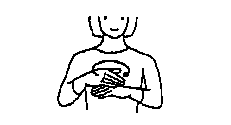 |
WITH LOVE ! |
By Masao Ito Reiko Tadana Shigeru Takemura Mihoko Taire |
|
Members of Research Group of Signing Communication |
||
CHAPTER 1 PURPOSE AND SIGNIFICANCE
Spoken language such as the Japanese language is represented with letters and voice according to several rules. We propose a siging system for representing the Japanese language with sign. We have named this system 'Siginig Exact Japanese', called 'SEJ' in this pamphlet. The purpose of SEJ is to represent the Japanese language exactly by using signs and lip-reading simultaneously.
(1) Education
SEJ would have the following merits in the educational field;
- SEJ can make the Japanese language more understandable for the deaf people than lips or signs used alone because SEJ can be used together with lips and can help lip-reading.
- SEJ can help to learn the Japanese language because it can represent the Japanese language exactly.
- SEJ can represent technical terms or words used in special fields which cannot be represented by traditional sign system.
(2) Social life
Sign language which has been used in deaf society traditionally includes many usages free from the Japanese language grammar, and has an abundance of expression power. For the reason, we expect that SEJ would play a role different from the traditional sign language.
- the roles of traditional sign language
- Communication in daily life
- Artistic field such as visual performance
- the roles of SEJ
- Communication in daily life (the same as the traditional sign language, but different from it in several meanings)
- Mass media such as television
- Representing technical terms or words used in special fields
- Situation that depends the Japanese language in high degree
- SEJ would improve deaf social-life and provide more opportunities of joining general society and performing various activities.
CHAPTER 2 BASIC RULES OF SEJ
One of SEJ's characteristics is to be presented with hands and fingers. The characteristic is useful for establishing SEJ system. We decided the following basic rules based on the characteristic.
Basic rules;
- One sign to one Japanese word rule
- Less movement to one sign word rule
- Combination with lip-reading rule
In the following sections, we will describe these rules.
- Basic rule 1 One sign to one Japanese word rule
If one Japanese word has more than one meaning, it is used variously ways. If we assign a sign for it according to the meaning, it need more than one sign word. In such case, signer must select the exact sign when he hears the Japanese word. It is desirable that one Japanese word has only one sign word. For example, a word 'agaru' has various of meanings such as 'to rise', 'to lose one's cool' and 'to increase'. But we assinged one sign for the word based on the rule as shown in figure 1.
traditional sign
when it means 'lose when it means 'rise'
one's cool', or'increase',
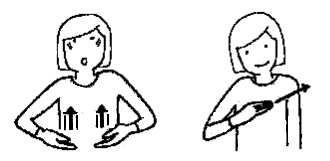
[left] The open hands, palm up, move up together.
[right] The right open hand,
palm down and fingers together,
moves up and leftward.
SEJ sign
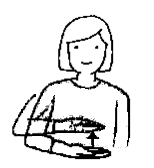
The right open hand,
palm up, moves up a bit
in front of the body.
The hand shape can be
include total meanings.
Figure 1 Example of basic rule 1
- Basic rule 2 Less movement to one sign rule
Hands and fingers can move in wider space than lips. Some of the traditional sign words have several movement, but those signs are often too long to represent with lips simultenously. We decided that the sign should take space as small as possible and should have movement as less as possible. Please refer to figure 2.
traditional sign
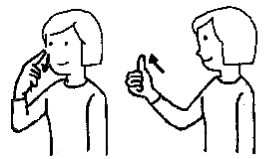
The right index finger touches on
the right cheek and moves down.
Then the right thumb is extended
and moves straight from the face.
SEJ sign
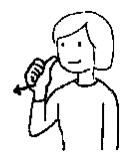
on the right cheek and moves down.
Then it moves straight out from
the face.
Figure 2 Example of basic rule 2
- Basic rule 3 Combination with lip-reading rule
If the meanings of two or more different words are very similiar to each other, the same sign should be assigned for these word. In such case,these words must be distinguished by lip-reading. In other words, sign represents superordinate category, while lip-reading would help to judge the meaning. For example, these words '法律(law)', '条例(ordinance)' and '規約(rule)' have similiar meanings each other. Though the same sign is assigned for these words, deaf people can distinguish from each other by lip-reading as shown in figure 3.
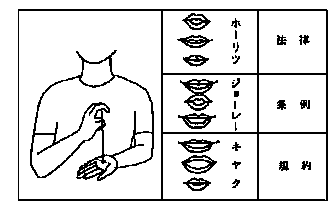 The right bended index and middle
The right bended index and middle
fingers moves down and are placed
on the palm of the left hand.
These words use the same sign,
but can be distinguished with lip-reading.
Figure 3 Example of basic rule 3
CHAPTER 3 KANJI-SIGN
As you know, the Japanese people use the Japanese kanji characters.
1. Availability of kanji-sign
The Japanese language would be represented exactly with sign by the rule. Though Japanese people (adult) can understand approximately 50000 words on average, it is impossible to create such number of signs and to memorize all of them.
Many of Japanese words use Japanese kanji and kana characters. If each Japanese kanji character is assigned a sign word, we can combine the sign words to represent Japanese words containing kanji characters. For example,if we determine that two kanji-signs '事'( thing or matter) and '物'(thing) should be used to represent a word '事物',we can use those kanji-signs for '品物'(product) or '事実'(fact).
A number of the Japanese kanji characters are less than Japanese word. And when deaf people will see kanji-signs, and remember the kanji character and the meaning, then the lister can understand the meaning moreclearly. Kanji-signs are useful for representing, especially, abstractwords.
2. Kanji-sign for Japanese kanji characters in common use
The ministry of Education decided in 1945 kanji characters in common use. We assigned sign for each of them. But kanji characters of low frequency in use need not sign to be represented. We decided sign for appoximately 1600 kanji characters in common use. If traditional sign word can be suitable for the kanji character, we adapted it.
3. Direction
a. Rules
- Only one sign must be assigned one kanji basically.
- The hand shape of kanji-sign must contain total meanings which the kanji character has.
b. Exceptions
i. Some kanji characters are read in more one pronounciation. For example,the Chinese pronounciation of a kanji character '通' is [tsu:]', while the Japanese pronounciations of it are [to:ru], [to:su] or [kayou]. If manual kana is used for such kanji characters, this manual kana must change according to pronounciation as shown in figure 4. NOTE: 'manual kana'... Each of 46 kana characters can be represented with manual just as manual alphabet. So we defined it 'manual kana'.
In Chinese pronounciation 'tsu:".

The right hand makes the
manual kana 'つ(tsu)',
and moves on the right
index finger forward.
In Japanese pronounci-ation 'to:ru' or 'to:su'

The right hand makes the
the manual kana 'と(to)'
and moves on the right
index finger forward.
In Japanese pronounci- ation 'kayo-u'.

The right hand makes
manual kana 'か(ka)'
and brush back and
forth over the left
index finger.
Figure 4 Example of exception 1
ii. If a meaning of kanji character clearly varies on its pronounciation, separate sign may be assigned according to the meaning. For example, a kanji character '治' means 'to dominate' when it is pronounciated 'osameru', 'osamaru'(in Japanese), 'ji" and "chi'(in Chinese),while it means 'to recover' when it is pronounciated 'naoru'(in Japanese).We assigned two signs for the kanji character as shown in figure 5.
when it means 'to recover'

The open right hand, turndowned
is placed on the palm of open
left hand, and is upsidedowned.
when it means 'to dominate'
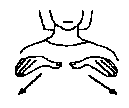
The open hands, turndowned, move
down with away from one another.
Figure 5 Example of exception 2
iii. In some case, two or more kanji characters have the same the Chinese pronounciation. If these kanji characters have the same or similiar meanings, the same sign should be assigned, if not, separate sign should be assigned.
4. Usage
Not all words containing kanji characters need to be represented by kanjisigns. For example, a word '先生' consists of two kanji characters '先'and '生', but we regard it a single word rather than a combination of kanji characters. In such case, the word '先生' need not be represented by use of kanji-signs and shall be assigned a sign.
5. Examples of kanji-signs
1) 愛 (love)
the Chinese pronounciation : ai
 The downturned open hands are crossed, and the right hand moves horizontal
circles on the left hand. (quated from "Watashitachi no shuwa"
vol.5)
The downturned open hands are crossed, and the right hand moves horizontal
circles on the left hand. (quated from "Watashitachi no shuwa"
vol.5)
2) 悪 (evil)
the Chinese pronounciation : aku
the Japanese pronounciation : warui
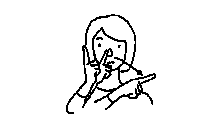 The right index finger moves leftward and a bit down ward, brushing lightly
the tip of nose. (quated from "Watashi -tachi no shuwa" vol.1)
The right index finger moves leftward and a bit down ward, brushing lightly
the tip of nose. (quated from "Watashi -tachi no shuwa" vol.1)
3) 圧 (pressure)
the Chinese pronounciation : atsu
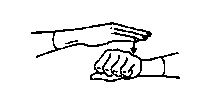 The right open hand, downturned, is placed on the back of the left fist
hand and press against it. And the hands down together.
The right open hand, downturned, is placed on the back of the left fist
hand and press against it. And the hands down together.
4) 安 (The kanji character has different means by pronounciation.)
the Chinese pronounciation : an (stable)
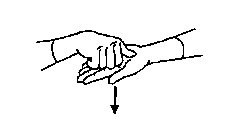
The right fist hand, downturned, is placed on the open left hand. And the hands move down together.
the Japanese pronounciation : yasui (cheep)
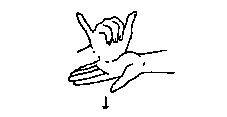 The right hand makes the mannual kana 'や(ya)' and put on the open left
hand. Then the hands move down together.
The right hand makes the mannual kana 'や(ya)' and put on the open left
hand. Then the hands move down together.
5) 暗 (darkness)
the Chinese pronounciation : an
the Japanese pronounciation : kurai
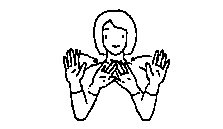 The open hands, palms out, and arms are raised, are crossed over each
other on the front of the face. (quatedfrom "Watashitachi no shuwa"vol.1)
The open hands, palms out, and arms are raised, are crossed over each
other on the front of the face. (quatedfrom "Watashitachi no shuwa"vol.1)
トップページ > ケムの手話研究 > SIGNING EXACT JAPANESE